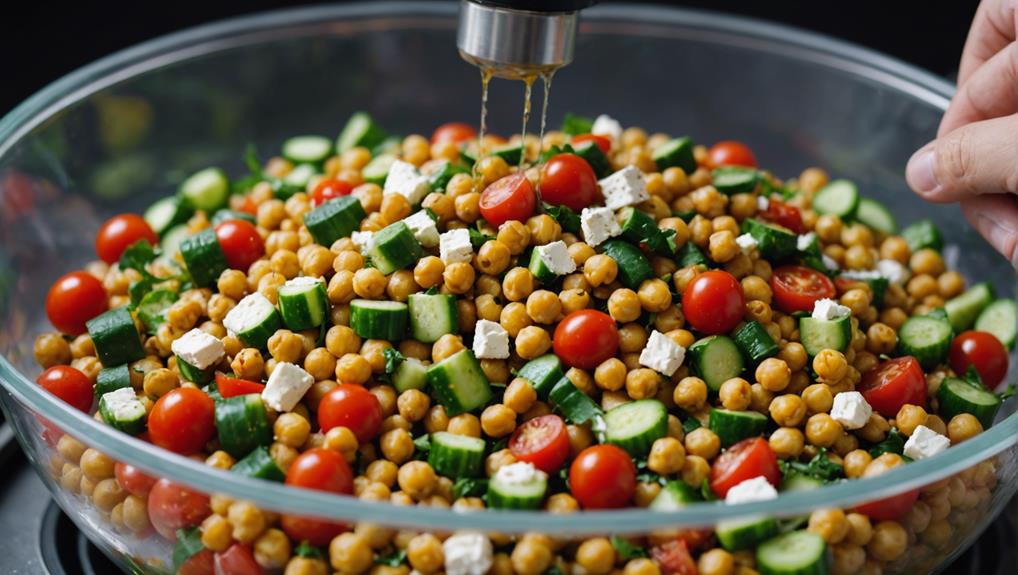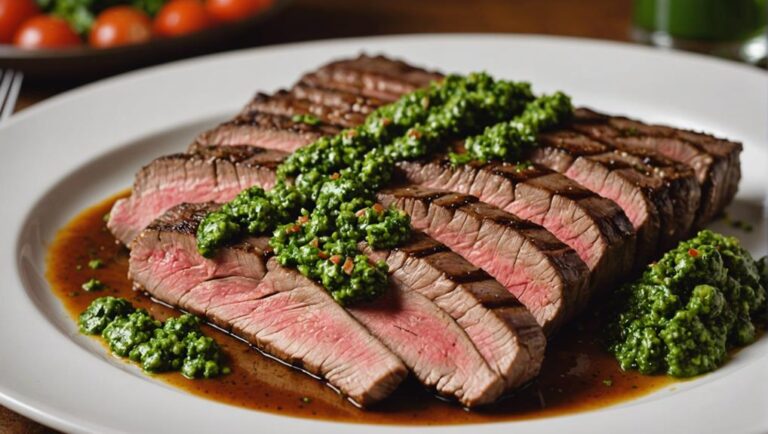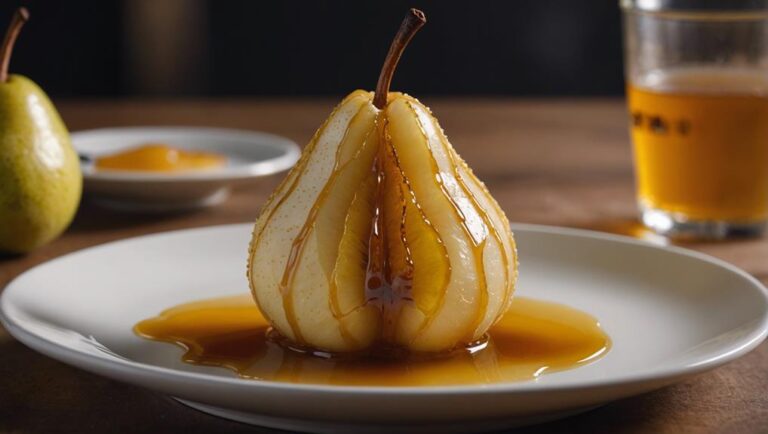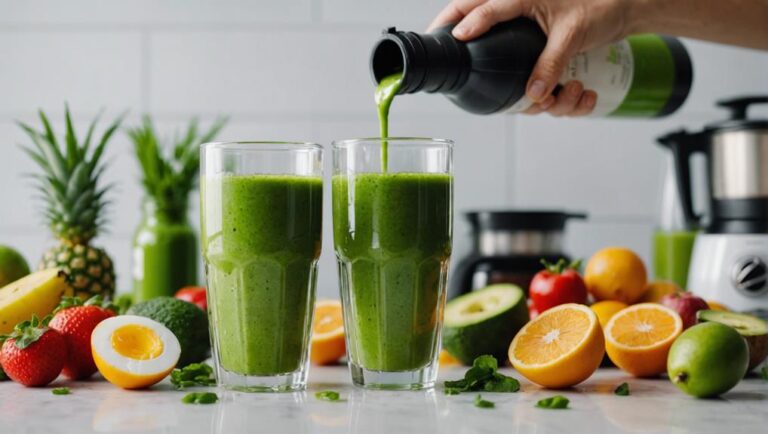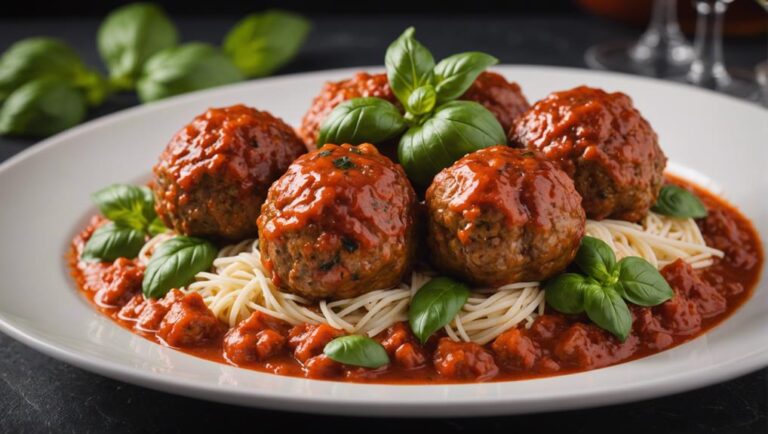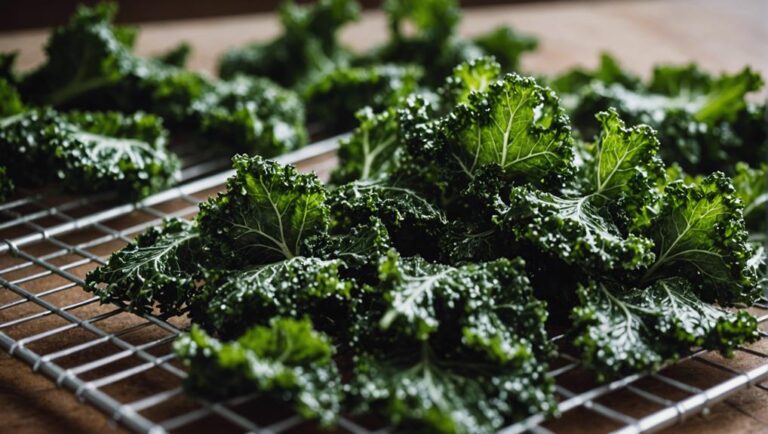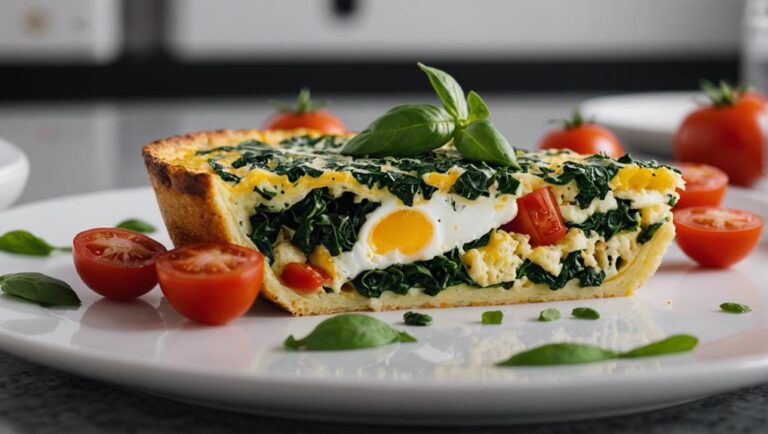Sous Vide Mediterranean Chickpea Salad
Explore how sous vide cooking enhances the flavors of Mediterranean chickpea salad. This method guarantees precise temperature control for uniformly cooked chickpeas while amplifying their taste and texture. The tangy notes from lemon, smoky dimension from roasted red peppers, and creamy element from Dijon mustard create a harmonious blend. With sous vide, you can effortlessly infuse different seasonings, enhancing the overall dish. Elevate your culinary experience with a perfect balance of flavors and textures that will leave your taste buds craving more.
What You Will Learn Here
- Sous vide method enhances chickpea texture and flavor.
- Precise temperature control ensures even cooking.
- Customizable seasoning options for personalized taste.
- Effortless preparation with streamlined cooking process.
- Mediterranean flavors from citrus, peppers, and olive oil.
Chickpeas in Ancient Mediterranean Cuisine

Chickpeas, also known as garbanzo beans, were a fundamental component of ancient Mediterranean cuisine, dating back to approximately 3000 BC.
Ancient Greeks and Romans incorporated chickpeas into a variety of dishes, such as salads, stews, and roasted snacks, highlighting their culinary versatility.
The high protein and fiber content of chickpeas made them a prized ingredient in the Mediterranean diet, showcasing their significance in traditional recipes.
Historical Chickpea Consumption
Having been cultivated for over 7,000 years in the Mediterranean region, chickpeas played a significant role in the diets of ancient civilizations like the Greeks, Romans, and Egyptians due to their nutritional value and culinary versatility. Historical records indicate that chickpeas were utilized in various forms, such as roasted snacks, stews, and salads. The ancient Mediterranean civilizations valued chickpeas as a staple food due to their high nutritional content, adaptability in dishes, and extended shelf life. This tradition of incorporating chickpeas into Mediterranean cuisine has persisted through the centuries, with modern adaptations and recipes continuing to showcase the versatility and flavor of this ancient legume.
| Ancient Chickpea Consumption |
|---|
| Nutritional Value |
| Versatility in Dishes |
| Long Shelf Life |
| Roasted Snacks |
| Stews and Salads |
Culinary Significance of Chickpeas
In ancient Mediterranean cuisine, the culinary significance of chickpeas was undeniable, with their versatility and nutritional richness making them a fundamental ingredient in a myriad of traditional dishes.
Chickpeas, also known as garbanzo beans, have been a staple in Mediterranean flavors for centuries. Ancient civilizations such as the Greeks and Romans highly valued chickpeas for their plant-based protein and fiber content. These legumes were integral to dishes like hummus, falafel, and salads in the Mediterranean region, providing essential nutrients to traditional diets.
Chickpeas played an essential role in sustaining populations and contributed greatly to the culinary heritage of the Mediterranean, showcasing their importance as a source of protein and fiber in ancient Mediterranean cuisine.
Traditional Chickpea Dishes
Shifting from the culinary significance of chickpeas in ancient Mediterranean cuisine, the exploration now centers on the traditional dishes that prominently feature these legumes, showcasing their enduring role in creating flavorful and nutritious meals throughout the region's rich culinary history.
Chickpeas have long been a cornerstone of Mediterranean cuisine, with dishes like hummus, falafel, Moroccan tagines, and Greek revithia standing out as prime examples. These traditional Mediterranean dishes not only highlight the versatility of chickpeas but also underscore their nutritional benefits.
Rich in protein and fiber, chickpeas provided sustenance and essential nutrients in ancient Mediterranean diets. Their adaptability in various culinary applications speaks to their importance in the gastronomic heritage of the Mediterranean region.
Chickpeas in Mediterranean Dishes
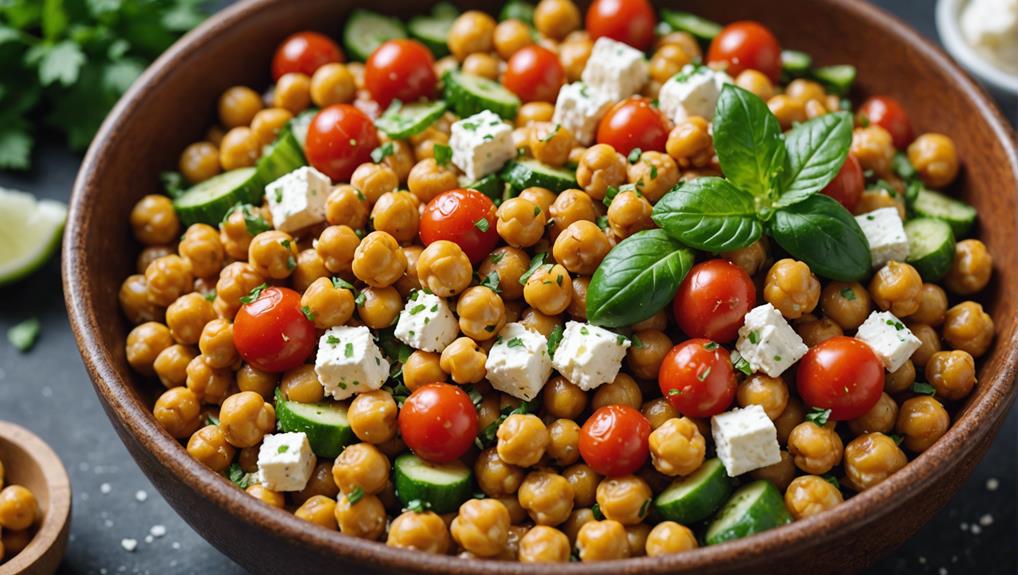
Chickpeas play an essential role in the rich tapestry of Mediterranean cuisine, serving as a cornerstone ingredient cherished for its nutritional value and culinary versatility. In Mediterranean dishes, chickpeas are highly valued for their protein and fiber content, making them a popular choice for those seeking a plant-based source of nutrients. Here are three key points to keep in mind when incorporating chickpeas into your Mediterranean culinary creations:
- Versatility: Chickpeas are incredibly adaptable and can be used in a variety of dishes, such as salads, hummus, and stews. Their mild flavor allows them to adjust well to different seasonings and ingredients, making them a go-to option in Mediterranean cooking.
- Nutritional Benefits: Chickpeas aren't only delicious but also packed with nutrients. They offer a good source of plant-based protein and fiber, which are essential for a balanced diet and overall well-being.
- Traditional Roots: Chickpeas have deep roots in Mediterranean cuisine and are featured prominently in traditional recipes like falafel, chickpea salads, and Mediterranean grain bowls. Embracing chickpeas in your dishes can help you connect with the authentic flavors of the region while reaping their health benefits.
Chickpea Salad Variations
Explore the versatility of chickpea salads with variations like Chickpea Salad With Feta, Chickpea Lentil Salad Bowl, and Mediterranean Chickpea Farro Salad.
These variations offer unique combinations of ingredients to cater to different tastes and preferences, allowing for a customizable culinary experience.
Experimenting with diverse components can help you discover new and exciting versions of the classic Mediterranean chickpea salad.
Chickpea Salad With Feta
To enhance the flavor profile of your Mediterranean Chickpea Salad, consider incorporating various types of feta cheese for a diverse and satisfying taste experience. Feta cheese adds a creamy and tangy flavor that complements the earthy and nutty taste of chickpeas.
Here are some variations to try with your chickpea salad:
- Crumbled traditional Greek feta for an authentic Mediterranean touch.
- Creamy French feta for a milder and smoother texture.
- Sharp Bulgarian feta for a more robust and tangy flavor.
These feta cheese options will elevate your chickpea salad, providing different taste profiles to suit your preferences. Enjoy the delightful combination of chickpeas and feta in this protein-rich vegetarian meal.
Chickpea Lentil Salad Bowl
For best meal preparation efficiency, consider incorporating time-saving shortcuts when assembling your Chickpea Lentil Salad Bowl. Here are some tips to streamline your meal prep process:
- Utilize canned chickpeas and pre-cooked lentils to save time.
- Make a batch of pickled red onions ahead of time for added flavor and convenience.
- Opt for store-bought hummus or harissa to cut down on preparation time.
Mediterranean Chickpea Farro Salad
To enhance the flavor and texture of your Chickpea Lentil Salad Bowl, consider elevating your meal with a satisfying and nutrient-packed Mediterranean Chickpea Farro Salad. This healthy salad combines the goodness of chickpeas and farro in a delicious Mediterranean-inspired dish. Here are three reasons why you should try this salad variation:
- Nutrient-Rich: Chickpeas and farro are packed with essential nutrients, making this salad a healthy choice.
- Satisfying Texture: The nutty flavor of farro and the creamy texture of chickpeas create a satisfying combination.
- Versatile Customization: Add fresh herbs, veggies, or your favorite dressing to customize this salad to your liking.
Experience the goodness of Mediterranean Chickpea Farro Salad for a wholesome and flavorful meal.
Enhancing Chickpea Salad Flavor
To enhance the flavor of your Mediterranean Chickpea Salad, consider incorporating flavor-boosting ingredients like olive oil, lemon juice, and oregano.
These elements can be infused using the sous vide method, ensuring a more intense and well-rounded taste.
Additionally, consider using fresh herb garnishes and precise seasoning techniques to elevate the overall flavor profile of your salad.
Flavor-Boosting Ingredients
Enhancing the flavor of your Mediterranean Chickpea Salad can be achieved by incorporating a variety of flavor-boosting ingredients.
Adding roasted red peppers will impart a smoky and bright flavor profile to the dish, while incorporating sumac into the dressing provides a tangy and citrusy note.
Utilizing Aleppo pepper adds a subtle heat and depth of flavor to the salad, creating a well-rounded taste experience.
Balancing these flavors with Dijon mustard in the dressing introduces a creamy and slightly tangy element that complements the other ingredients perfectly.
Seasoning Tips
For an enhanced flavor experience in your Mediterranean Chickpea Salad, consider incorporating a blend of Dijon mustard, lemon, garlic, Aleppo pepper, sumac, salt, and pepper into the dressing. These ingredients create a harmonious balance of flavors that elevate the taste profile of the salad.
Adding roasted red peppers brings a smoky and bright dimension, enhancing the overall depth of the dish. Before serving, adjusting the seasoning with avocado can introduce creaminess and richness to the salad.
Utilizing extra virgin olive oil in the dressing not only adds a Mediterranean touch but also contributes to the salad's overall flavor. By carefully combining these elements, you can create a delicious and vibrant Mediterranean-inspired chickpea salad that's sure to impress your taste buds.
Fresh Herb Garnishes
Considering the vibrant flavor profile already established in your Mediterranean Chickpea Salad, incorporating fresh herb garnishes such as parsley, mint, and cilantro can further enhance the dish with their aromatic and nutritious qualities.
These fresh herbs not only add a Mediterranean flair to your salad but also contribute essential vitamins and minerals. Parsley adds a burst of vitality, mint provides a cool and invigorating undertone, while cilantro infuses a citrusy note. The visual appeal is heightened by the vibrant colors of the herbs, making the dish even more enticing.
Including a variety of fresh herbs in your Healthy Recipes not only elevates the taste but also offers a customizable experience, allowing you to tailor the salad to suit your preferences.
Final Thoughts
In conclusion, the Sous Vide Mediterranean Chickpea Salad introduces a culinary innovation that enhances the cooking process and improves the final dish's quality. This technique of cooking enables precise temperature control, guaranteeing that the chickpeas are evenly cooked while maintaining excellent flavor. The customizable seasoning options, such as red pepper flakes and lemon juice, offer a lively taste profile that can be tailored to individual preferences. Utilizing canned chickpeas in the sous vide method streamlines the preparation without compromising on taste or texture. The sous vide approach not only boosts the flavors of the salad but also enhances the overall texture of the ingredients, producing a delectable and harmonious dish. By integrating sous vide into the Mediterranean Chickpea Salad, you have the flexibility to explore and experiment with various seasoning combinations, crafting a dish that is both flavorful and satisfying.
| Ingredients | Benefits |
|---|---|
| Precise Cooking | Ensures uniform cooking |
| Flavor Retention | Amplifies taste |
| Customizable | Tailor seasoning to taste |
| Texture Improvement | Enhances overall texture |
| Simplified Process | Effortless preparation |
Frequently Asked Questions
Can Chickpeas Be Substituted With Other Legumes in the Salad?
Yes, you can substitute chickpeas with other legumes in the salad. Lentils, black beans, or white beans are great alternatives. Guarantee similar texture and flavor compatibility. Experiment to find your preferred legume for a delightful twist.
How Should Chickpeas Be Stored to Maintain Freshness?
To maintain chickpeas' freshness, store them in an airtight container in a cool, dry place. Avoid exposure to moisture and sunlight. Proper storage helps preserve texture and flavor, ensuring that your chickpeas remain fresh for an extended period.
What Other Ingredients Can Be Added to Chickpea Salad for Extra Crunch?
For extra crunch in your chickpea salad, consider adding ingredients like toasted nuts, seeds, or crispy vegetables. These additions not only provide texture but also enhance the overall flavor profile of your dish.
Can Chickpea Salad Be Prepared in Advance and Stored for Later?
Yes, chickpea salad can be prepared in advance and stored for later. To maintain freshness and texture, store it in an airtight container in the refrigerator for up to 3-4 days. Enjoy the convenience of a ready-to-eat meal!
Are Canned Chickpeas as Nutritious as Dried Chickpeas in the Salad?
Yes, canned chickpeas are as nutritious as dried chickpeas in the salad. Both provide essential nutrients like protein, fiber, and vitamins. Canned chickpeas are convenient and retain most of their nutritional value, making them a practical choice.
Conclusion
Overall, sous vide cooking offers a unique and precise method for creating flavorful and tender Mediterranean chickpea salads. By infusing the chickpeas with herbs and spices at a controlled temperature, the dish becomes a burst of Mediterranean flavors.
Experimenting with different variations and flavor profiles allows for endless possibilities in creating a delicious and nutritious salad.
Embrace the sous vide method to elevate your chickpea salad game to the next level.
